Nuclear ethics
| Nuclear weapons |
|---|
 |
| Background |
| Nuclear-armed states |
|
Nuclear ethics is a cross-disciplinary field of academic and policy-relevant study in which the problems associated with
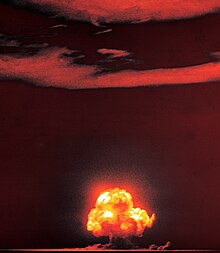
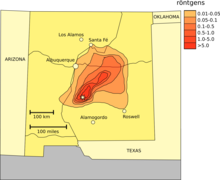
Nuclear ethics is interested in examining policies of nuclear deterrence, nuclear arms control and disarmament, and nuclear energy insofar as they are linked to the cause or prevention of nuclear warfare. Ethical justifications of nuclear deterrence, for example, emphasize its role in preventing great power nuclear war since the end of World War II.[7] Indeed, some scholars claim that nuclear deterrence seems to be the morally rational response to a nuclear-armed world.[8] Moral condemnation of nuclear deterrence, in contrast, emphasizes the seemingly inevitable violations of human and democratic rights which arise.[9]
Early ethical issues
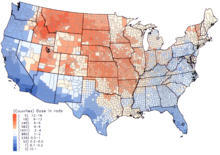
The application of nuclear technology, both as a source of energy and as an instrument of war, has been controversial.[10][11][12][13]
Even before the first nuclear weapons had been developed, scientists involved with the Manhattan Project were divided over the use of the weapon. The role of the two atomic bombings of the country in Japan's surrender and the U.S.'s ethical justification for them has been the subject of scholarly and popular debate for decades. The question of whether nations should have nuclear weapons, or test them, has been continually and nearly universally controversial.[14]
The public became concerned about
Some local opposition to nuclear power emerged in the early 1960s,[18] and in the late 1960s some members of the scientific community began to express their concerns.[19] In the early 1970s, there were large protests about a proposed nuclear power plant in Wyhl, Germany. The project was cancelled in 1975 and anti-nuclear success at Wyhl inspired opposition to nuclear power in other parts of Europe and North America. Nuclear power became an issue of major public protest in the 1970s.[20]
Uranium mining and milling
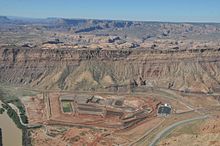
Between 1949 and 1989, over 4,000 uranium mines in the Four Corner region of the American Southwest produced more than 225,000,000 tons of uranium ore. This activity affected a large number of Native American nations, including the Laguna, Navajo, Zuni, Southern Ute, Ute Mountain, Hopi, Acoma and other Pueblo cultures.[21][22] Many of these peoples worked in the mines, mills and processing plants in New Mexico, Arizona, Utah and Colorado.[23] These workers were not only poorly paid, they were seldom informed of dangers nor were they given appropriate protective gear.[24] The government, mine owners, scientific, and health communities were all well aware of the hazards of working with radioactive materials at this time.[25][26] Due to the Cold War demand for increasingly destructive and powerful nuclear weapons, these laborers were both exposed to and brought home large amounts of radiation in the form of dust on their clothing and skin.[27] Epidemiologic studies of the families of these workers have shown increased incidents of radiation-induced cancers, miscarriages, cleft palates and other birth defects.[28] The extent of these genetic effects on indigenous populations and the extent of DNA damage remains to be resolved.[29][30][31][32] Uranium mining on the Navajo reservation continues to be a disputed issue as former Navajo mine workers and their families continue to suffer from health problems.[33]
Notable nuclear weapons accidents
- 13 February 1950: a atomic bomb. This was the first such nuclear weapon lossin history.
- 22 May 1957: a 42,000-pound Mark-17 hydrogen bomb accidentally fell from a bomber near Albuquerque, New Mexico. The detonation of the device's conventional explosives destroyed it on impact and formed a crater 25-feet in diameter on land owned by the University of New Mexico. According to a researcher at the Natural Resources Defense Council, it was one of the most powerful bombs made to date.[34]
- 7 June 1960: the BOMARC Missile Accident Sitein New Jersey.
- 24 January 1961: the B-52 Stratofortress carrying two Mark 39 nuclear bombs broke up in mid-air, dropping its nuclear payload in the process.[35][36]
- 1965 Philippine Sea A-4 crash, where a Skyhawk attack aircraft with a nuclear weapon fell into the sea.[37] The pilot, the aircraft, and the B43 nuclear bomb were never recovered.[38] It was not until the 1980s that the Pentagon revealed the loss of the one-megaton bomb.[39]
- 17 January 1966: the hydrogen bombs the B-52G carried,[41] three were found on land near Almería, Spain. The non-nuclear explosives in two of the weapons detonated upon impact with the ground, resulting in the contamination of a 2-square-kilometer (490-acre) (0.78 square mile) area by radioactive plutonium. The fourth, which fell into the Mediterranean Sea, was recovered intact after a 2½-month-long search.[42]
- 21 January 1968: the hydrogen bombs when a cabin fire forced the crew to abandon the aircraft. Six crew members ejected safely, but one who did not have an ejection seat was killed while trying to bail out. The bomber crashed onto sea ice in Greenland, causing the nuclear payload to rupture and disperse, which resulted in widespread radioactive contamination.
- 18–19 September 1980: the
Nuclear fallout

Over 500 atmospheric nuclear weapons tests were conducted at various sites around the world from 1945 to 1980.
As public awareness and concern mounted over the possible health hazards associated with exposure to the nuclear fallout, various studies were done to assess the extent of the hazard. A Centers for Disease Control and Prevention/ National Cancer Institute study claims that fallout from atmospheric nuclear tests would lead to perhaps 11,000 excess deaths amongst people alive during atmospheric testing in the United States from all forms of cancer, including leukemia, from 1951 to well into the 21st century.[46][47] As of March 2009, the U.S. is the only nation that compensates nuclear test victims. Since the Radiation Exposure Compensation Act of 1990, more than $1.38 billion in compensation has been approved. The money is going to people who took part in the tests, notably at the Nevada Test Site, and to others exposed to the radiation.[48][49]
Nuclear labor issues
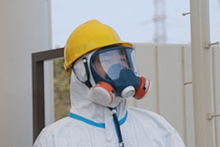
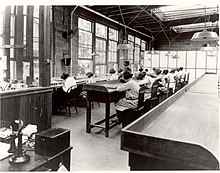
Existent labor laws protecting worker's health rights are not properly enforced.[56] Records are required to be kept, but frequently they are not. Some personnel were not properly trained resulting in their own exposure to toxic amounts of radiation. At several facilities there are ongoing failures to perform required radiological screenings or to implement corrective actions.
Many questions regarding these nuclear worker conditions go unanswered, and with the exception of a few whistleblowers, the vast majority of laborers – unseen, underpaid, overworked and exploited, have few incentives to share their stories.[57] The median annual wage for hazardous radioactive materials removal workers, according to the U.S. Bureau of Labor Statistics is $37,590 in the U.S – $18 per hour.[58] A 15-country collaborative cohort study of cancer risks due to exposure to low-dose ionizing radiation, involving 407,391 nuclear industry workers, showed significant increase in cancer mortality. The study evaluated 31 types of cancers, primary and secondary.[59]
Civil liberties
Nuclear power is a potential target for
Human radiation experiments
The
References
- S2CID 144502441.
- ISBN 978-0-02-923091-6.
- ISBN 978-0-521-54526-6.
- ISBN 978-0-521-69422-3.
- ^ Szasz, Paul C. (2004). "2". In Sohail H. Hashmi and Steven P. Lee (ed.). Ethics and Weapons of Mass Destruction: Religious and Secular Perspectives. Cambridge: Cambridge University Press. pp. 43–72.
- S2CID 202244223.
- ^ Nye, Joseph S Jr. (1986). "5". Nuclear Ethics. New York: The Free Press. pp. 59–80.
- JSTOR 2025707.
- ^ Shue, Henry (2004). "7". In Sohail H. Hashmi and Steven P. Lee (ed.). Ethics and Weapons of Mass Destruction: Religious and Secular Perspectives. Cambridge: Cambridge University Press. pp. 139–162.
- ^ "Sunday Dialogue: Nuclear Energy, Pro and Con". The New York Times. 25 February 2012.
- ^ Robert Benford. The Anti-nuclear Movement (book review) American Journal of Sociology, Vol. 89, No. 6, (May 1984), pp. 1456–1458.
- ^ James J. MacKenzie. Review of The Nuclear Power Controversy by Arthur W. Murphy The Quarterly Review of Biology, Vol. 52, No. 4 (Dec. 1977), pp. 467–468.
- ^ Jim Falk (1982). Global Fission: The Battle Over Nuclear Power, Oxford University Press.
- ^ Jerry Brown and Rinaldo Brutoco (1997). Profiles in Power: The Anti-nuclear Movement and the Dawn of the Solar Age, Twayne Publishers, pp. 191–192.
- ^ Woo, Elaine (30 January 2011). "Dagmar Wilson dies at 94; organizer of women's disarmament protesters". Los Angeles Times.
- ^ Hevesi, Dennis (23 January 2011). "Dagmar Wilson, Anti-Nuclear Leader, Dies at 94". The New York Times.
- ^ a b c Wolfgang Rudig (1990). Anti-nuclear Movements: A World Survey of Opposition to Nuclear Energy, Longman, pp. 54–55.
- ^ Garb, Paula. "Review of Critical Masses". Journal of Political Ecology. 6: 1999.
- ^ Wolfgang Rudig (1990). Anti-nuclear Movements: A World Survey of Opposition to Nuclear Energy, Longman, p. 52.
- ^ Jim Falk (1982). Global Fission: The Battle Over Nuclear Power, Oxford University Press, pp. 95–96.
- ISBN 978-0-691-12076-8.
- ISBN 978-1-4165-9482-6.
- ISBN 978-0-415-91770-4.
- ISBN 978-1-930618-82-4.
- ^ Brugge, Doug; Timothy Benally, Ester Yazzie Lewis (9 April 2010). "Uranium Mining on Navajo Indian Land". Partnering with Indigenous Peoples to Defend their Lands, Languages and Cultures. Cultural Survival.org. Retrieved 31 March 2014.
{{cite web}}: CS1 maint: multiple names: authors list (link) - ISBN 978-0-295-97749-2.
- ISBN 978-0-87081-662-8.
- ^ Laramee, Eve Andree. "Tracking Our Nuclear Legacy: Now we are all sons of bitches". 2012. WEAD: Women Environmental Artist Directory. Retrieved 31 March 2014.
- ^ Frosh, Dan (26 July 2009). "Uranium Contamination Haunts Navajo Country". The New York Times. Retrieved 31 March 2014.
- ISBN 978-1-930618-82-4.)
{{cite book}}: CS1 maint: multiple names: authors list (link - ISBN 978-0-8263-3779-5.)
{{cite book}}: CS1 maint: multiple names: authors list (link - ^ Jung, Carrie. "Navajo Nation Opposes Uranium Mine on Sacred Site in New Mexico". Al Jazerra. Retrieved 31 March 2014.
- ^ Reese, April (12 May 2011). "Navajo Group to Take Uranium Mine Challenge to Human Rights Commission". The New York Times. Retrieved 21 April 2014.
- ^ "Accident Revealed After 29 Years: H-Bomb Fell Near Albuquerque in 1957". Los Angeles Times. Associated Press. 27 August 1986. Retrieved 31 August 2014.
- ^ Barry Schneider (May 1975). "Big Bangs from Little Bombs". Bulletin of the Atomic Scientists. p. 28. Retrieved 13 July 2009.
- ISBN 978-1-4357-0361-2. Retrieved 29 December 2008.
- ^ "Ticonderoga Cruise Reports" (Navy.mil weblist of Aug 2003 compilation from cruise reports). Retrieved 20 April 2012.
The National Archives hold[s] deck logs for aircraft carriers for the Vietnam Conflict.
- ^ Broken Arrows at www.atomicarchive.com. Accessed 24 August 2007.
- ^ "U.S. Confirms '65 Loss of H-Bomb Near Japanese Islands". The Washington Post. Reuters. 9 May 1989. p. A–27.
- ^ Hayes, Ron (17 January 2007). "H-bomb incident crippled pilot's career". Palm Beach Post. Archived from the original on 16 June 2011. Retrieved 24 May 2006.
- ISBN 978-0-89745-214-4.
- ^ Long, Tony (17 January 2008). "Jan. 17, 1966: H-Bombs Rain Down on a Spanish Fishing Village". WIRED. Retrieved 16 February 2008.
- ISBN 978-1-59420-227-8.
- ^ Christ, Mark K. "Titan II Missile Explosion". The Encyclopedia of Arkansas History & Culture. Arkansas Historic Preservation Program. Retrieved 31 August 2014.
- ^ Stumpf, David K. (2000). Christ, Mark K.; Slater, Cathryn H. (eds.). "We Can Neither Confirm Nor Deny" Sentinels of History: Refelections on Arkansas Properties on the National Register of Historic Places. Fayetteville: University of Arkansas Press.
- ^ "Report on the Health Consequences to the American Population from Nuclear Weapons Tests Conducted by the United States and Other Nations". CDC. Retrieved 7 December 2013.
- PMID 25057651– via www.nap.edu.
- ^ "International". ABC News.
- ^ "Radiation Exposure Compensation System: Claims to Date Summary of Claims Received by 06/11/2009" (PDF).
- ^ Efron, Sonni (30 December 1999). "System of Disposable Laborers". Los Angeles Times. Retrieved 28 March 2014.
- ^ Wald, Matthew L. (29 January 2000). "U.S. Acknowledges Radiation Killed Weapons Workers". New York Times. Retrieved 28 March 2014.
- ^ Iwaki, H.T. (8 October 2012). "Meet the Fukushima 50? No, you can't". The Economist. Retrieved 28 March 2014.
- ^ Bagne, Paul (November 1982). "The Glow Boys: How Desperate Workers are Mopping Up America's Nuclear Mess". Mother Jones. VII (IX): 24–27. Retrieved 28 March 2014.
- ^ Efron, Sonny (30 December 1999). "System of Disposable Laborers". Los Angeles Times. Retrieved 1 April 2014.
- ^ Petersen-Smith, Khury. "Twenty-first century colonialism in the Pacific". IRS. Retrieved 1 April 2014.
- PMID 19570756.
- ^ Krolicki, Kevin and Chisa Fujioka. "Japan's "throwaway" nuclear workers". Reuters, MMN: Mother Nature Network. Archived from the original on 2 September 2011. Retrieved 1 April 2014.
- ^ Bureau of Labor Statistics. "Hazardous Materials Removal Workers". Retrieved 1 April 2014.
- S2CID 36282894.
- Independent.co.uk.
- ^ Martin, B. (2015). Nuclear power and civil liberties EnergyScience – The Briefing Paper 23 (pp. 1–6) Australia.
- ISBN 978-0-385-31954-6.
